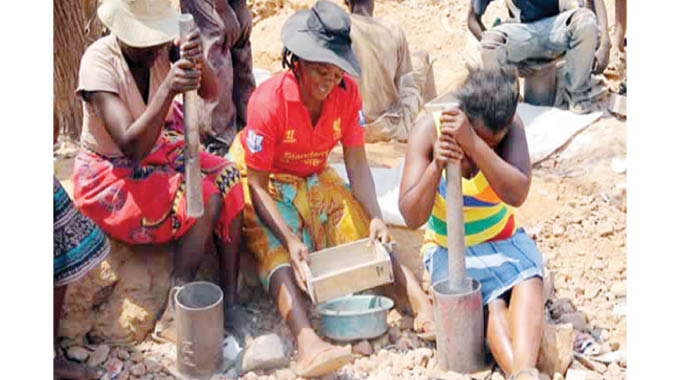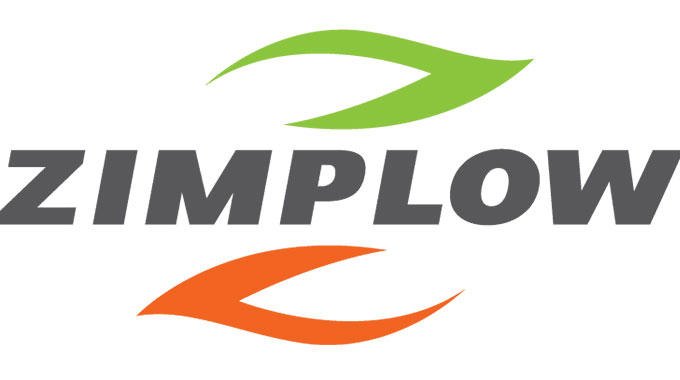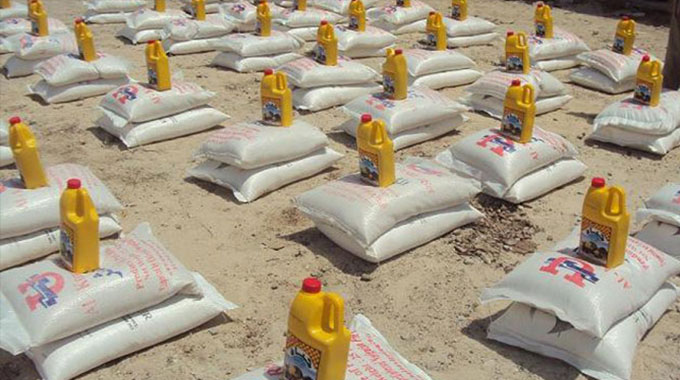Gender inequality, health and safety of women in small-scale mining

Gibson Mhaka, Senior Features Reporter
NARRATING her life as a female miner, Ms Joyce Mpofu (54), a single mother from Bubi District of Matabeleland North province, shared incidents that threaten her health and safety daily as a woman in the artisanal and small-scale mining (ASM) sector.
These vary from intimidation, discrimination, name calling, sexualised talk, display of body parts and the exchange of sexual favours for promotion.
According to Ms Mpofu, a former vegetable vendor, working in the ASM as a woman is challenging.
“Men always make explicit remarks or refuse to accept the authority or capabilities of women. I have seen it, experienced it first-hand and heard many more horrible and serious stories than what has happened to me,” she says with a distant look.
Her facial expressions were explanation enough as she insisted that the ASM sector in the country remains perilous and notoriously inhospitable to women.
The experiences Ms Mpofu says she has endured are not isolated. Women are routinely subjected to demeaning behaviour in the ASM industry which undoubtedly inhibits their potential to enable a positive livelihood development through mining.
Her experiences are also a living testimony that women in mining, particularly in the gold mining sector, are experiencing a number of challenges such as victimisation by male miners, dispossession of their claims, and various other forms of gender-based violence, resulting in many women fearing to venture into mining.
Women in ASM are also exposed to harmful effects of physical, chemical and economic hazards that compromise their occupational safety and health conditions.
Although there is a critical lack of data, women are believed to account for up to 10 percent of Zimbabwe’s estimated 535 000 people who earn a direct livelihood from the ASM industry.
Traditionally, mining is an adult male domain, but economic hardship and declining agricultural production have forced women and children into this sector, especially gold mining.
According to the International Labour Organisation (ILO) women provide about 50 percent of the labour force for ASM, but their compensation lags behind that of their male counterparts, or remain unpaid as it comes in the form of assistance to the male family members engaged in such work.
According to gender and mining experts, women’s struggle for livelihoods has brought them to the periphery of the mining fields as vendors. Some are primarily involved in crashing, sluicing, washing, panning and sieving.
This position is validated by research by the Zimbabwe Environmental Law Association (ZELA) which has been lobbying for safe space and amplifying voices of women in the ASM sector.
ZELA media and communications officer Ms Clarity Sibanda said while women play a significant role in the ASM sector, they have not been spared from harassment and abuse from their male counterparts.
“Women in mining have not been spared from harassment and abuse from their male counterparts. Beyond the differences between the male and female miners in ASM, lies a story of how societal and gendered hierarchies and power dynamics shape the industry. Socially constructed ideas have invented assumptions favouring men and these influence power and leadership dynamics, encouraging female miners to play a subservient role.
“In most syndicates male miners are assumed to be the leaders due to their biological make up and women play supporting roles. We have been calling on Government to legalise artisanal mining while ensuring that women are protected from the challenges they face,” she said.
Ms Sibanda said the recent robbery of Mthandazo Women Miners in Gwanda by machete-wielding robbers who got away with their gold ore and money has placed the spotlight on the plight of women in ASM and also recognised the importance of implementing measures to enhance their safety.
Another female artisanal miner from Inyathi, Ms Sicelo Dube conceded that patriarchy is still very present in ASM. She said this should be challenged as it impedes their potential to enable a positive livelihood development through mining.
“Women face challenges which they would not otherwise face if they were men; such as bullying, discrimination and physical abuse. In some instances, they have to perform sexual favours and those who refuse fall victim to harassment. And because you are with men out there in the bush there are also some natural hazards, like you fear being robbed or killed,” she said.
From her observation it is clear that failure to lobby for safe space for women especially in ASM may hamper progress towards meeting the sustainable development goals in 2030.
Speaking at a workshop for Sustainable Mining in Zimbabwe, hosted by Transparency International Zimbabwe in Bulawayo late last year, Ms Nomuhle Ncube of Bubi Small-Scale Miners’ Association called for support and protection from the police saying women in mining were victims of violence.
She said as women, they have been caught up in skirmishes that have taken the lives of many and injured others.
Zimbabwe Miners Federation (ZMF) chief executive officer Mr Wellington Takavarasha acknowledged incidents of sexual harassment and ill-treatment of women in the ASM sector saying they were cause for serious concern which requires a shift in policy and legislation to protect them.
“It is true that in many areas women in ASM still face significant challenges such as disrespect, harassment and physical abuse sometimes in the form of rape which also occasionally goes unreported. However, as ZMF we are working towards changing perceptions of the sector as not being for men only,” said Mr Takavarasha.
He said female miners have also not been spared by the spate of machete violence perpetrated in all gold-rich areas across the country.
“Although they are attacking everyone they suspect to have money, women have also become more vulnerable to machete attacks especially those known to be doing good business,” he said.
So, what can be done for all female miners to feel safe?
“In order to improve the health and safety of women in artisanal and small-scale mining, we are calling on the Government to put in place a legal framework that guarantees their security,” said Mr Takavarasha.
Apart from rampant abuse by their male colleagues, women in artisanal mining have to contend with a lot of challenges among them lack of equipment, pollution, low returns and poor working conditions.
Ms Florence Mbizvo (50) from Gweru who was dispossessed of her mining claim in Shurugwi after the death of her husband said women are further geologically excluded from mineral-rich areas due to cultural barriers that amount to economic exclusion.
“When they evicted me from my mining claim, it was like they had never seen a woman before. They took all my equipment including pumps and generators. I was repeatedly threatened, humiliated and groped.
“Those men who evicted me from my mining claim were working with someone from the Provincial Mining Director’s office to frustrate vulnerable miners, especially women.
“These are some of the problems we are facing as women. A woman is often not given priority when applications for claims are tendered.
“Some people in positions of power create too many obstacles for women to own mining claims, making them wait in hope or simply not giving them priority or information on time when such opportunities arise,” said Ms Mbizvo.
Since women are a vulnerable segment of the mining sector, special attention should be afforded to them, both in the areas of occupational safety and health as well as in the provision of more sustainable and environmentally viable forms of employment and productivity.
As part of efforts to respond to mining related emergencies, ZELA with support from Red Cross and other international organisations are also training and sensitising female miners on international best practices of working in a safe environment that also prioritises their safety and health.
“Having noticed the gap and the need for First Aid to respond to mining related emergencies as Zimbabwe Environmental Law Association with support from Irish Aid and the EU we have taken it upon ourselves to include First Aid as part of our safety, health and environment training,” said Ms Sibanda.
In light of these issues, several strategies need to be put in place to ensure that initiatives to upscale artisanal and small-scale mining in the country are transformative in the lives of women and girls in the sector.
Gender sensitive approaches and strategies that centre on occupational health and safety of women in ASM should be implemented.
Meanwhile, the Government’s commitment to gender equality and involvement of women in mining as a prerequisite for poverty reduction, and sustainable development is affirmed by its ratification and being a signatory to various international and regional protocols on gender equality.
For example, the Southern African Development Community (Sadc) Women in Mining Trust which was established in 1996 with the aim of considering the needs, problems and constraints faced by women in ASM. According to the Trust, key challenges facing women miners in the region are mine safety, knowledge of environmentally sustainable approaches to mining and access to finance, training and skills development.










Comments